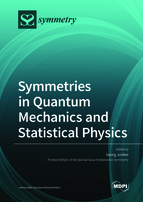Symmetries in Quantum Mechanics and Statistical Physics
A special issue of Symmetry (ISSN 2073-8994). This special issue belongs to the section "Physics".
Deadline for manuscript submissions: closed (30 September 2021) | Viewed by 21470
Special Issue Editor
2. Institut für Theoretische Physik I, Universität Erlangen-Nürnberg, Staudtstraße 7, D-91058 Erlangen, Germany
Interests: supersymmetric quantum mechanics; classical N-vector models; group-theoretical and path-integral methods in physics
Special Issue Information
Dear Colleagues,
Symmetry is a fundamental concept in science and has played a significant role since the early days of quantum physics. For example, the rotational symmetry of Coulomb interactions is key in the group theoretic classification of atomic spectra, and its dynamical SO(4) symmetry accounts for the accidental degeneracy of the H atom spectrum. In physics, symmetry characterises the invariance of a system under certain transformations, being either discrete like mirror symmetry or continuous like rotational symmetry. In mathematics, symmetries are described by group theoretic means.
Symmetry methods are still powerful tools in contemporary problems of quantum mechanics and statistical physics, and they go beyond the classical Lie groups and algebras. Examples are the so-called supersymmetric quantum mechanics and the PT invariance of non-Hermitian Hamiltonians. In this Special Issue of Symmetry, we invite original contributions which utilise symmetry methods to understand and solve problems related to the keywords listed below. However, it is also open to other topics related to quantum mechanics and/or statistical physics where symmetry plays a key role.
Priv.-Doz. Dr. Georg Junker
Guest Editor
Manuscript Submission Information
Manuscripts should be submitted online at www.mdpi.com by registering and logging in to this website. Once you are registered, click here to go to the submission form. Manuscripts can be submitted until the deadline. All submissions that pass pre-check are peer-reviewed. Accepted papers will be published continuously in the journal (as soon as accepted) and will be listed together on the special issue website. Research articles, review articles as well as short communications are invited. For planned papers, a title and short abstract (about 100 words) can be sent to the Editorial Office for announcement on this website.
Submitted manuscripts should not have been published previously, nor be under consideration for publication elsewhere (except conference proceedings papers). All manuscripts are thoroughly refereed through a single-blind peer-review process. A guide for authors and other relevant information for submission of manuscripts is available on the Instructions for Authors page. Symmetry is an international peer-reviewed open access monthly journal published by MDPI.
Please visit the Instructions for Authors page before submitting a manuscript. The Article Processing Charge (APC) for publication in this open access journal is 2400 CHF (Swiss Francs). Submitted papers should be well formatted and use good English. Authors may use MDPI's English editing service prior to publication or during author revisions.
Keywords
- Schrödinger- and Pauli-Hamiltonians
- relativistic wave equations
- Feynman and Wiener path integrals
- supersymmetric quantum mechanics
- PT symmetry and complex potentials
- group coherent states
- Fokker–Planck and Langevin equation
- Ising models and spin systems
- classical vector models
Benefits of Publishing in a Special Issue
- Ease of navigation: Grouping papers by topic helps scholars navigate broad scope journals more efficiently.
- Greater discoverability: Special Issues support the reach and impact of scientific research. Articles in Special Issues are more discoverable and cited more frequently.
- Expansion of research network: Special Issues facilitate connections among authors, fostering scientific collaborations.
- External promotion: Articles in Special Issues are often promoted through the journal's social media, increasing their visibility.
- e-Book format: Special Issues with more than 10 articles can be published as dedicated e-books, ensuring wide and rapid dissemination.
Further information on MDPI's Special Issue polices can be found here.






